历史
Main article: History of the University of California, Los Angeles
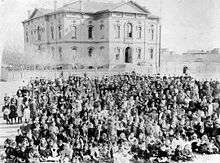
The Los Angeles branch of California State Normal School, in 1881.
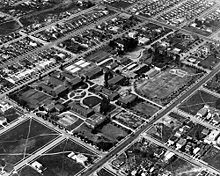
University of California, Southern Branch's Vermont Campus, 1922.
Beginnings
In March 1881, after heavy lobbying by Los Angeles residents, the California State Legislature authorized the creation of a southern branch of the California State Normal School (which later became San Jose State University) in downtown Los Angeles to train teachers for the growing population of Southern California. The State Normal School at Los Angeles opened on August 29, 1882, on what is now the site of the Central Library of the Los Angeles Public Library system. The new facility included an elementary school where teachers-in-training could practice their teaching technique on children. That elementary school is related to the present day version, UCLA Lab School. In 1887, the school became known as the Los Angeles State Normal School.
In 1914, the school moved to a new campus on Vermont Avenue (now the site of Los Angeles City College) in Hollywood. In 1917, UC Regent Edward A. Dickson, the only regent representing the Southland at the time, and Ernest Carroll Moore, Director of the Normal School, began working together to lobby the State for the school to become the second University of California campus, after Berkeley. The Berkeley Alumni, Northern California members of the state legislature and Benjamin Ide Wheeler, President of the University of California from 1899 to 1919 fought the idea of a southern campus. David Prescott Barrows, the new President of the University of California did not have the objections of Wheeler. On May 23, 1919, the Southern Californians efforts were rewarded when Governor William D. Stephens signed Assembly Bill 626 into law, which turned the campus into the Southern Branch of the University of California and added its general undergraduate program, the College of Letters and Science. The Southern Branch campus opened on September 15 of that year, offering two-year undergraduate programs to 250 Letters and Science students and 1,250 students in the Teachers College, under Moore's continued direction.
University of California President William Wallace Campbell saw enrollment at the Southern Branch expanded so rapidly that by the mid-1920s the institution was outgrowing the 25 acre Vermont Avenue location. The Regents conducted a search for a new location and announced their selection of the so-called "Beverly Site"—just west of Beverly Hills—on March 21, 1925. After the athletic teams entered the Pacific Coast conference in 1926, the Southern Branch student council adopted the nickname "Bruins," a name offered by the student council at Berkeley. In 1927, the Regents renamed the school itself the "University of California at Los Angeles" (the word "at" was officially replaced by a comma in 1958, in line with other UC campuses) and the state broke ground in Westwood on land sold for $1 million, less than one-third its value, by real estate developers Edwin and Harold Janss, for whom the Janss Steps are named.
The original four buildings were the College Library, Royce Hall, the Physics-Biology Building, and the Chemistry Building (now Powell Library, Royce Hall, the Humanities Building, and Haines Hall, respectively), arrayed around a quadrangular courtyard on the 400 acre (1.6 km²) campus. The first undergraduate classes on the new campus were held in 1929 with 5,500 students. In 1933, after further lobbying by alumni, faculty, administration and community leaders, UCLA was permitted to award the Master's degree, and in 1936, the doctorate, against resistance from Berkeley.
Maturity as a university
By the 1950s, UCLA had developed into a serious and widely respected research institution. University of California President Robert Gordon Sproul, called Berkeley and Los Angeles, "a two legged-university." The campus received its first chancellor in 1951, thereby establishing itself as an autonomous entity within the UC system. The appointment of Franklin David Murphy to the position of Chancellor in 1960 helped to spark an era of tremendous growth of facilities and faculty honors. By the end of the decade, UCLA had achieved distinction in a wide range of subjects. This era also secured UCLA's position as a proper university in her own right and not simply a branch of the UC system. This change is exemplified by an incident involving Chancellor Murphy, which was described by him later on:
"I picked up the telephone and called in from somewhere, and the phone operator said, 'University of California.' And I said, 'Is this Berkeley?' She said, 'No.' I said, 'Well, who have I gotten to?' 'UCLA.' I said, 'Why didn't you say UCLA?' 'Oh,' she said, 'we're instructed to say University of California.' So the next morning I went to the office and wrote a memo; I said, 'Will you please instruct the operators, as of noon today, when they answer the phone to say, "UCLA."' And they said, 'You know they won't like it at Berkeley.' And I said, 'Well, let's just see. There are a few things maybe we can do around here without getting their permission.'"
In 2006, the university completed Campaign UCLA, which collected over $3.05 billion and is the second most successful fundraising campaign. In 2008, UCLA raised over $456 million, ranking the institution among the top 10 universities in the United States in total fundraising for the year.
校园
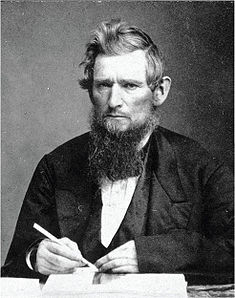
Aerial photo of UCLA campus
When UCLA opened its new campus in 1919, it had four buildings. Today, the campus includes 163 buildings across 419 acres (1.7 km²) in the western part of Los Angeles, north of the Westwood shopping district and just south of Sunset Boulevard. The campus is close but not adjacent to the San Diego Freeway.
The first campus buildings were designed by the local firm Allison & Allison. The Romanesque Revival style of these first four structures remained the predominant building style on campus until the 1950s, when architect Welton Becket was hired to supervise the expansion of the campus over the next two decades. Becket greatly streamlined the general appearance of the campus, adding several rows of minimalist, slab–shaped brick buildings to the southern half of the campus, the largest of these being the UCLA Medical Center. Architects such as A. Quincy Jones, William Pereira and Paul Williams designed many subsequent structures on the campus during the mid-20th century. More recent additions include buildings designed by architects I.M. Pei, Venturi, Scott Brown and Associates, Richard Meier, Cesar Pelli, and Rafael Vinoly. In order to accommodate UCLA's rapidly growing student population, multiple construction and renovation projects are in progress, including expansions of the life sciences and engineering research complexes. This continuous construction gives UCLA the on-campus nickname of "Under Construction Like Always."
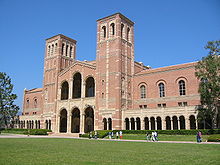
Royce Hall, one of the original four buildings of the campus, has become the symbol of UCLA, taking inspiration from Italian Basilica of Sant'Ambrogio, in Milan
The campus includes sculpture gardens, fountains, museums, and a mix of architectural styles. It is located in the residential area of Westwood and bordered by Bel-Air, Beverly Hills, and Brentwood. The campus is informally divided into North Campus and South Campus, which are both on the eastern half of the university's land. North Campus is the original campus core; its buildings are more old-fashioned in appearance and clad in imported Italian brick. North Campus is home to the arts, humanities, social sciences, law, and business programs and is centered around oak tree-lined Dickson Court. South Campus is home to the physical sciences, life sciences, engineering, psychology, mathematical sciences, all health-related fields, and the UCLA Medical Center.
Ackerman Union, the John Wooden Center, the Arthur Ashe Health and Wellness Center, the Student Activities Center, Kerckhoff Hall, the J.D. Morgan Center, the James West Alumni Center, and Pauley Pavilion stand at the center of the campus. Bruin Walk, a heavily traveled pathway from housing to the main campus, bisects the campus.
The tallest building on campus is named after Ralph Bunche, an African-American alumnus, who received the 1950 Nobel Peace Prize for negotiating an armistice agreement between the Jews and Arabs in Palestine. A bust of him, on the entrance to Bunche Hall, overlooks the Franklin D. Murphy Sculpture Garden. He was the first individual of non-European background and the first UCLA alumnus to be honored with the Prize.
A mile from campus, the UCLA Hannah Carter Japanese Garden is located in the community of Bel-Air. The garden was designed by landscape architect Nagao Sakurai of Tokyo and garden designer Kazuo Nakamura of Kyoto in 1959. After the garden was damaged by heavy rains in 1969, UCLA Professor of Art and Campus Architect Koichi Kawana took on the task of its reconstruction.
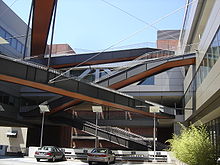
California Nanosystems Institute, interior walkways built over a parking structure.
The campus has a large number of parking garages, both above-ground and below-ground. Yet, the university continues to suffer from a severe parking shortage which is further compounded by Southern California's regional housing shortage. The university has given priority in allocation of parking spaces to staff and some students, regardless of living distances. There are many facilities with local buses. There are, in addition, other transportation services that the university provides for its students, such as "rideshares" and vanpools. Also, the "BruinGo" program allows students and staff members to use local bus services (such as Santa Monica's Big Blue Bus, initially used as a free initiative) for a reduced fare from numerous terminals located on the campus.
With a location near Hollywood and a world-famous film and television school, the UCLA campus has attracted filming for decades. Much of the 1985 film Gotcha! was shot at UCLA, as well as John Singleton's Higher Learning (1995). Legally Blonde, "Old School", "The Nutty Professor", Erin Brockovich, and American Pie 2 all were mainly shot at the university campus or locale. In January 2009, the Bollywood movie My Name is Khan was shot at UCLA. Some of the exterior shots of the fictional UC Sunnydale in Buffy the Vampire Slayer were also filmed at UCLA. In response to the major demand for filming, UCLA instated a policy on filming and professional photography at the campus. "UCLA is located in Los Angeles, the same place as the American motion picture industry," said UCLA visiting professor of film and television Jonathan Kuntz. "So we're convenient for (almost) all of the movie companies, TV production companies, commercial companies and so on. We're right where the action is."
学术
UCLA Healthcare
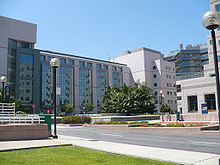
UCLA Medical Plaza is near the main entrance to the campus
The David Geffen School of Medicine, along with the School of Nursing, School of Dentistry, and School of Public Health, comprise the professional schools of health science. In 2005, UCLA announced its five-year plan to establish the Institute for Stem Cell Biology and Medicine; the state of California is rare in its public funding of research with new embryonic stem cell lines. The California NanoSystems Institute is another project that was created out of a partnership with the University of California, Santa Barbara to pioneer innovations in the field of nanotechnology.
The Ronald Reagan UCLA Medical Center is a part of a larger healthcare system, UCLA Healthcare, which also operates a hospital in Santa Monica and seven primary care clinics throughout Los Angeles County. In addition, the UCLA David Geffen School of Medicine uses two Los Angeles County public hospitals as teaching hospitals—Harbor-UCLA Medical Center and Olive View-UCLA Medical Center—as well as the largest private nonprofit hospital on the West Coast, Cedars-Sinai Medical Center. In 1981, the UCLA Medical Center made history when an assistant professor named Michael Gottlieb first diagnosed an unknown affliction later to be called AIDS. UCLA medical researchers also pioneered the use of PET scanning to study brain function. The signaling cascade of nitric oxide, one of the most important molecules in cardiopulmonary physiology was discovered in part by the medical school's Professor of Pharmacology Louis J. Ignarro. For this, he was awarded the 1998 Nobel Prize in Medicine or Physiology along with two other researchers - Robert F. Furchgott of the SUNY Health Science Center and Ferid Murad of the University of Texas Medical School at Houston.
In the 2007 edition of U.S. News and World Report, UCLA Medical Center was ranked best in the West, as well as one of the top 3 hospitals in the United States alongside Mayo Clinic, Cleveland Clinic, Massachusetts General Hospital, and Johns Hopkins Hospital. In 15 of the 16 medical specialty areas examined, UCLA Medical Center ranked in the top 20.
Rankings
|
|
University rankings (overall)
|
|
| ARWU World |
13th |
| ARWU North & Latin America |
11th |
| Times Higher Education |
30th |
| USNWR National University |
24th |
| WM National University |
3rd |
Global rankings
UCLA was ranked 12th in Newsweek's annual ranking of the Top 100 Global universities. In 2007, UCLA was ranked 13th in the world (11th in North America) by Top 500 World Universities, an annual list published by the Institute of Higher Education at Shanghai Jiao Tong University, China. UCLA was ranked 18th in the country and 30th in the world by The Times Higher Education Supplement’s list of the top 200 universities in the world.
U.S. rankings
U.S. News & World Report ranked UCLA as the 2nd best public university among "National Universities" in the United States and 24th among "America's Best Colleges 2010: National Universities". In the August 21–28, 2006 issue of Newsweek (also released as the 2007 issue of the Kaplan Guide to Colleges), UCLA was listed as one of "25 New Ivies". The Washington Monthly ranks UCLA third nationally with criteria based on research, community service, and social mobility.
UCLA took the second spot among all universities (surpassed only by Johns Hopkins University), and the top spot among public universities, for research spending in the sciences and engineering during the fiscal year 2004, according to a 2006 report by the National Science Foundation—UCLA spent $773 million.
Graduate schools
Anderson School of Management, School of Public Affairs, and School of Medicine consistently rank among the top ten in the United States. UCLA's oldest operating unit, the Graduate School of Education and Information Studies (GSEIS), was ranked second among American graduate schools of education in the 2006 edition of U.S. News and World Report, America's Best Graduate Schools.
Departments and professors
In 1995, of the 36 Ph.D. programs examined by the National Research Council, eleven departments were ranked in the top ten. Thirty-one of the Ph.D. programs examined were ranked in the top 20, the third highest number of those distinctions in the country.
In the Institute for Scientific Information's 2004 database, 48 UCLA professors were listed as highly cited, making UCLA faculty 11th in the United States; as of December 2006, there were 54 highly cited faculty.
Library system
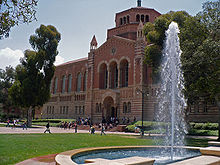
Powell Library, located across the quad from Royce Hall.
Main article: University of California, Los Angeles, library system
UCLA's library system has over eight million books and 70,000 serials spread over twelve libraries and eleven other archives, reading rooms, and research centers. It is the nation's 11th largest library in number of volumes.
The first library, University library (presently Powell), was founded in 1884. In 1910, Elizabeth Fargo became the university's first librarian. Lawrence Powell became librarian in 1944, and began a series of system overhauls and modifications, and in 1959, he was named Dean of the School of Library Service. More libraries were added as previous ones filled. Page Ackerman became University Librarian in 1973, and was the nation's first female librarian of a system as large as UCLA's. She oversaw the first coordinations between other UC schools, and formed a new administrative network that is still in use today. Since her retirement, the system has seen steady growth and improvement under various Librarians. The present University Librarian is Gary E. Strong, who has been in office since September 1, 2003.
Admissions
Undergraduate
Fall freshman statistics
| |
2010 |
2009 |
2008 |
2007 |
2006 |
2005 |
| Applicants |
57,651 |
55,676 |
55,397 |
50,732 |
47,317 |
42,232 |
| Admits |
13,020 |
12,098 |
12,579 |
11,860 |
12,189 |
11,361 |
| % Admitted |
22.58 |
21.73 |
22.70 |
23.38 |
25.76 |
26.90 |
This table does not account deferred
applications or other unique situations.
UCLA is rated "Most Selective", by the Princeton Review, with an admissions selectivity rating of 98 (on a scale of 60–99). UCLA received 55,397 applications for the Fall 2008 freshman class, retaining its position as the university with the most freshmen applicants, a title it has held since 1998. For the 2008-09 year, 12,579 applicants were admitted, 22.7% of the total. In 2009, UCLA became the most selective public university in the United States, edging out UC Berkeley and UVA to be the top public university in terms of selectivity.
| Ethnic enrollment, 2007 |
Under-
graduates |
Graduate
students |
| African American |
865 |
438 |
| Asian American and Pacific Islander |
9,968 |
2,253 |
| Hispanic or Chicano |
3,812 |
974 |
| Native American |
108 |
63 |
| White |
8,861 |
4,643 |
| International, Other |
1,075 |
1,695 |
| Total |
25,928 |
11,548 |
3,220 transfer students entered UCLA in Fall 2008, 90 percent from community colleges. Over the past 15 years over 45,000 transfer students have entered UCLA. One-third of baccalaureate degrees are awarded to students who entered UCLA as transfer students. One of the major current debates is over the decreasing admission of African-Americans and 拉丁语os, especially since the passage of Proposition 209, prohibiting racial, sexual, or ethnic discrimination at public institutions, in 1996. Out of the 4,700 students in the Fall 2006 class, 96 were African American, and 20 of those were recruited athletes. This is the lowest number of African Americans to enter into a class at UCLA in more than 30 years, and it comes at a time when the other schools in the UC system are seeing an increase. In response to this issue, UCLA decided to shift to a more holistic admissions process, similar to that of UC Berkeley, starting Fall 2007. Preliminary data show that the overall number of underrepresented student applicants at UCLA — Native Americans, African Americans, and Chicanos/Latinos — increased from 10,097 in fall 2006 (22.2% of 2006 applicants) to 11,414 for fall 2007 (23.6%). 35% of admitted students receive federal Pell grants. The top five overlapping schools for applicants are: UC Berkeley, Stanford University, Harvard University, Yale University, and Princeton University.
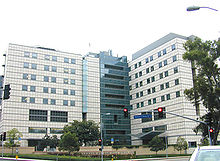
Mattel Children's Hospital at the Ronald Reagan Medical Center
Graduate
In Fall 2005, the David Geffen School of Medicine admitted 4.5% of its applicants, the School of Law admitted 16.1%, and the Anderson School of Management admitted 30.6%.
According to the American Dental Education Association (ADEA) Guide to Dental Schools, 44th Ed., the UCLA School of Dentistry had more than 1,465 applicants for 88 seats in the entering class of 2006. The average Dental Admissions Test (DAT) scores for admitted students in the entering class of 2007 were 22 on the academic portion (3rd highest average in the nation after Harvard and Columbia) and 20 on the perceptual aptitude portion of the exam (3rd highest average after Harvard and University of Washington).
Economic impact
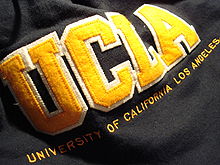
A hoodie from the UCLA store
The University has a significant impact in the Los Angeles Economy. It is the fourth largest employer in the county, after Los Angeles County, LAUSD and the Federal Government, and the seventh largest in the region. In 2005-2006, the university had an operating budget of $3.6 billion, of which 17.4% was from California state government appropriations.
Trademarks and licensing
The UCLA trademark also sells as an overseas clothing and accessories brand. This trend arises from the school's athletic and academic reputation, and popular images of the Southern California lifestyle. High demand for UCLA apparel has inspired the licensing of its trademark to UCLA brand stores throughout East Asia. Since 1980, 15 UCLA stores have opened in South Korea, and 43 are currently open in China. There are also stores in Mexico, Singapore, and Europe. UCLA makes $400,000 in royalties every year through its international licensing program.
体育运动
Main article: UCLA Bruins
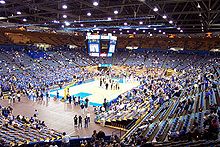
Pauley Pavilion is the main basketball venue
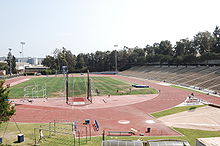
Drake Stadium is UCLA's track and field stadium.
The school's sports teams are called the Bruins, with colors "true blue" (an official shade of blue) and gold. The Bruins participate in NCAA Division I-A as part of the Pacific-10 Conference. Two notable sports facilities serve as home venues for UCLA sports. The Bruin men's football team plays home games at the Rose Bowl in Pasadena, California; the team won a national title in 1954. The men's and women's basketball and men's and women's volleyball teams, and the gymnastics team (women's) play at Pauley Pavilion on campus. The school also sponsors men's and women's cross country, men's and women's soccer, women's rowing, men's and women's golf, men's and women's tennis, and men's and women's water polo.
The Bruin mascots are Joe and Josephine Bruin, and the fight songs are Sons of Westwood and Mighty Bruins. The alma mater is Hail to the Hills of Westwood.
When Henry "Red" Sanders came to UCLA to coach football in 1949, the uniforms were redesigned. Sanders added a gold loop on the shoulders—the UCLA Stripe. The navy blue was changed to a lighter shade of blue. Sanders figured that the baby blue would look better on the field and in film. He dubbed the baby blue uniform "Powder Keg Blue," a powder blue with an explosive kick. This would also differentiate UCLA from its older brother, UC Berkeley (and all other UC teams, as all UC campuses' official colors are blue and gold). UCLA is competitive in all major Division I-A sports and has won 124 national championships, including 105 NCAA championships, more than any other university. The university recently won the 2008 NCAA Men's Golf Championship earning UCLA's 103rd NCAA championship. More recently, Women's Gymnastics won the 105th National Championship, on April 23, 2010. Among these championships, some of the more notable victories are in men's basketball.
Under legendary coach John Wooden, UCLA men's basketball teams won 10 NCAA championships, including a record seven consecutive, in 1964, 1965, 1967, 1968, 1969, 1970, 1971, 1972, 1973, and 1975, and an 11th was added under then-coach Jim Harrick in 1995 (through 2008, the most consecutive by any other team is two). From 1971 to 1974, UCLA men's basketball won an unprecedented 88 consecutive games. UCLA has also shown dominance in men's volleyball, with 19 national championships. All 19 teams were led by current coach Al Scates, which ties him with John McDonnell of the University of Arkansas as NCAA leader for national championships in a single sport.
UCLA has medaled in every Olympic Games they have participated in. In the 2004 Athens games, UCLA sent 56 athletes, more than any other university, who won 19 medals.
Former UCLA basketball player and current Indiana Pacers player Earl Watson commented, "Eleven national championships, the best coach (Wooden) to coach the game says a lot. I take offense to those who act like UCLA is just another school compared with Duke. Duke is a great school in the east, but UCLA is worldwide."
USC rivalry
Main article: UCLA-USC rivalry
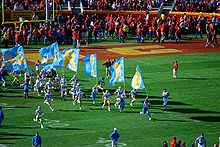
UCLA Bruins entering the LA Coliseum in 2007
UCLA shares a traditional sports rivalry with the nearby University of Southern California. USC is generally perceived as the dominant football team, while UCLA tends to succeed in basketball. In football, UCLA has one national champion team and 16 conference titles. Under John Wooden, UCLA became a dominating power in men's basketball, and has won 11 NCAA championships, against USC's none.
The schools share a rivalry in many other sports. In volleyball, UCLA won 19 NCAA Men's Volleyball Championships against USC's four.. UCLA also dominates the all-time series vs. USC in men's volleyball (86-34). In women's volleyball UCLA leads the all-time series against USC as well . In the popular sport of soccer UCLA leads USC in the all-time series 13-3-0. Both schools have won sixteen NCAA Men's Tennis Championships. The Lexus Gauntlet is the name given to the official competition between the two schools in 18 varsity sports. This rivalry even extends to the Olympic Games, where UCLA athletes have won 213 medals and USC athletes have won 234.
The origin is unclear, but the rivalry most likely started when football Hall of Fame coach Red Sanders led UCLA to dominance in the 1950s. USC, long before established as the reigning power, diverted its attention from then-rival University of Notre Dame, and the rivalry began.
Presently, UCLA, Stanford, and USC have the most NCAA championships; UCLA holds the most, winning a combined 105 team championships in men's and women's sports, with Stanford coming in second with 95, followed by USC with 89.
[edit] Student life
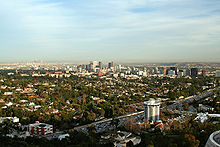
View of West Los Angeles from the Getty Center. Westwood and UCLA are in the middle ground.
Students have access to a variety of activities when not attending class. The campus' location in Los Angeles makes excursions to local museums, theaters, or other entertainment venues relatively quick and easy. UCLA offers classical orchestras, intramural sports, and over 800 student organizations. UCLA is also home to more than 60 national and local Greek-letter organizations, which collectively constitute the largest membership-based and multi-faceted community on campus. Fraternity and sorority members represent 13% of the student population. The student government at UCLA is the Associated Students UCLA (ASUCLA), governed by a student majority board of directors. It is the umbrella organization that includes the two branches of UCLA's student government, the Graduate Students Association (GSA) and the Undergraduate Students Association Council (USAC), the UCLA Store, the Student Union, Restaurants, Trademark & Licensing, and Student Media (including the UCLA Daily Bruin). The Student Alumni Association (SAA), a branch under the UCLA Alumni Association but entirely student run, is responsible for maintaining and putting on UCLA's oldest and greatest traditions, such as Blue and Gold Week, Senior Send-off, Spring Sing, and Dinners for 12 Strangers amongst many. UCLA also operates a waterfront facility known as the UCLA Marina Aquatic Center in Marina del Rey. Students and staff participate in dingy sailing, surfing, windsurfing, rowing, and kayaking.
The UCLA community was shocked in 2009 when a student was stabbed multiple times, including in the neck, during a chemistry lab class. Lab classes were canceled the next day and counselors were available for students.
Traditions
The university has many traditions and annual events involving students, community, or the city. The school hosts events that usually require participation from more than just the student body, and competitions can occasionally involve celebrity judges and performers.
Unicamp, founded in 1934, is UCLA's official charity. It is a week-long summer camp for underserved children from the greater Los Angeles area, with UCLA volunteer counselors. Because Unicamp is a non-profit organization, student volunteers from UCLA also fundraise money throughout the year to allow these children to attend summer camp.
To introduce new students to clubs and activities, UCLA begins the fall quarter with Welcome Week activities (renamed True Bruin Welcome in 2009). The week includes the newly-added Day of Service for all first-years, the Enormous Activities Fair, the Sports Fair, and other events. At the end of move-in and the beginning of Welcome Week, UCLA holds BruinBash. The BruinBash includes a concert, movie, and entertainment. Past performers include Thrice and Common in 2005, Xzibit and Rooney in 2006, T.I. in 2007, The Cool Kids, Estelle, and HelloGoodbye in 2008, and LMFAO in 2009. BruinBash was created as a replacement for Black Sunday, a large-scale day of partying including all fraternities, in North Westwood Village, where the majority of off-campus students reside adjacent to campus.
Dance Marathon is an annual event held in Ackerman Grand Ballroom at UCLA, where thousands of students raise money and dance to support the Elizabeth Glaser Pediatric AIDS Foundation, Project Kindle, and One Heartland. Dancers are highly encouraged to fundraise a minimum amount of $208 before the event, which is a 26 hour dance marathon. Dancers are not allowed to sit (except to use the restroom) during the marathon. In 2010, Dance Marathon of UCLA raised a record-breaking $400,000. Since 2002, the Marathon has raised over $2,100,000.
UCLA students also participate in "Midnight Yell" during finals week, a tradition where every night at midnight (starting on Sunday of finals week), students go outside and yell as loudly as possible for one minute, giving everyone a chance to take a short break from studying and release some nervous energy. Students who live in on-campus housing are not allowed to participate.
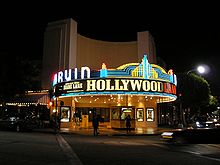
Bruin Theater, Westwood Village
The quarterly Undie Run takes place during the Wednesday evening of Finals Week, when students run through the campus in their underwear or in skimpy costumes. The run first began in Fall of 2001 when a student, Eric Whitehead, wearing what he described as "really short shorts" walked around singing a song and playing a guitar to protest the Police restrictions on the Midnight Yell. With the increasing safety hazards and Police and Administration involvement, a student committee, in order to satisfy concerns but keep the event, changed the route. It was changed to a run through campus to the fountain in front of Powell Library. Now it ends with students cavorting in the fountains outside Powell Library. As attendance increased, committees in charge of organizing the event deemed it necessary to employ the UC Police during the event, to ward off vandalism and dangerous activity. In 2007, the route was changed again to begin at Strathmore and Gayley Avenues instead of Landfair and Gayley Avenues. Tired of the UCLA administration meddling in student-initiated spontaneous traditions, students have begun celebrating finals week in new ways. One way is the "Undie Ride," where students run a predetermined route in their underwear on Tuesday night of finals week. In the summer of 2009, the administration cancelled all future undie run events, citing safety concerns. (The Undie Run concept has since spread to other college campuses around the United States, including the University of Texas at Austin and Syracuse University.)
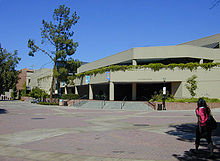
John Wooden Recreation Center on the campus of UCLA.
The Alumni Association sponsors several events, usually large extravaganzas involving huge amounts of coordination. An example of this is the 60-year old Spring Sing, organized by the Student Alumni Association (SAA). Spring Sing is UCLA's oldest tradition—it is an annual gala of student talent, which is held at the Los Angeles Tennis Center on campus. In 2009 the event was held in UCLA's Pauley Pavilion. The committee bestows the George and Ira Gershwin Lifetime Achievement Award each year to a major contributor to the music industry. Past recipients have included Stevie Wonder, Frank Sinatra, Ella Fitzgerald, James Taylor, Ray Charles, Natalie Cole, Quincy Jones, Lionel Richie, and in 2009, Julie Andrews. The Dinner for 12 Strangers, a common tradition among universities, is a gathering of students, alumni, administration and faculty to network around different interests. The week before the USC rivalry football game, there is a "Beat 'SC Bonfire and Rally. The bonfire did not take place in 2006 due to fire hazard issues. Nonetheless, UCLA won the football game, upsetting the #2 ranked Trojans. This led many to believe that dispelling of the tradition led to the victory. the Band for UCLA." The brothers had presented a new fight song, adopted from their musical Strike Up the Band, to the university.
Various student groups organize schoolwide fundraisers such as the Jazz Reggae Festival, a two-day concert on Memorial Day weekend that attracts more than 20,000 attendees.
Student government
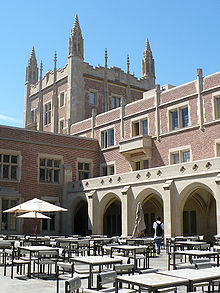
Kerckhoff Hall houses the offices of student government and the
Daily Bruin.
The Associated Students UCLA (ASUCLA) is the official entity encompassing student government and student-led enterprises at UCLA. ASUCLA is comprised of four major components: the Undergraduate Students Association, the Graduate Students Association, Student Media, and services & enterprises. However, in common practice, the term ASUCLA is often more narrowly used to refer to the services and enterprises component. This includes the Student Store, Bookstore, Food Services, Student Union, etc. These commercial enterprises serving the UCLA campus community generate approximately $90,000,000 in annual revenues, making it financially the largest student government operation in the world. As a nonprofit corporation, the financial goal of ASUCLA is not to maximize return or "profit" but to provide quality services and programs to the campus community at reasonable prices. ASUCLA is governed by a student-majority Board of Directors. The Undergraduate Students Association and Graduate Students Association each appoint three members plus one alternate. The respected presidents of USA and GSA usually serve as chair and vice chair of the board, alternating in the middle of the year. In addition to the student members, there are representatives appointed by the administration, the academic senate, and the alumni association. The "services and enterprises" portion of ASUCLA is run by a professional executive director who oversees some 300 professional career staff and 2,000 student employees. The board meets monthly and is responsible for setting the priority goals for the year, providing direction to the executive director, and evaluating his or her annual performance.
The Graduate Students Association is the governing body for approximately 11,000 graduate and professional students at UCLA.
"USAC" is an acronym for Undergraduate Students Association Council, the governing body of the Undergraduate Students Association (USA) whose membership comprises every UCLA undergraduate student. The student body currently has two major political slates, Bruins United and Students First!.
USAC's thirteen student officers and commissioners are elected by members of the Undergraduate Students Association at an annual election held during Spring Quarter. In addition to its thirteen elected members, USAC includes appointed representatives of the Administration, the Alumni, and the Faculty, as well as two ex-officio members, the ASUCLA Executive Director and a student Finance Committee Chairperson who is appointed by the USA President and approved by USAC. All members of USAC may participate fully in Council deliberations, but only the thirteen elected student members have a vote.
The USA President appoints more than seventy undergraduates to administrative committees and the Academic Affairs Commissioner Appoints approximately 25 undergraduates to Academic Senate Committees. Students have an opportunity to serve on the ASUCLA Board of Directors and the Communications Board, as well as on other significant committees. Through their participation on these campus-wide committees, UCLA undergraduates have had input into the decision making process at a high level.
USA's programs offer an invaluable service to the campus and surrounding communities and provide an opportunity for thousands of students to participate in and benefit from these endeavors. For example, each year approximately 40,000 students, faculty and staff attend programs of the Campus Events Commission, including a low-cost film program, a speakers program which presents leading figures from a wide range of disciplines, and performances by dozens of outstanding entertainers. Two to three thousand UCLA undergraduates participate annually in the more than twenty voluntary outreach programs run by the Community Service Commission. A large corps of undergraduate volunteers also participate in programs run by the Student Welfare Commission, such as AIDS Awareness, Substance Abuse Awareness, Blood Drives and CPR/First Aid Training.
Student Media UCLA is the home of UCLA's student-run media, including the campus newspaper, magazines, and radio and television stations.
Media publications
Most student media publications distributed on-campus are governed by the ASUCLA Communications Board. The Daily Bruin is UCLA's most prominent student publication. Founded in 1919 under the name Cub Californian, it has since then developed into Los Angeles' third-most circulated newspaper. It has won over 20 national awards in the last five years, and is regularly commended for layout and content. In 2006, the Society of Professional Journalists awarded it Best All-Around Daily Newspaper in the national Mark of Excellence Awards. The newspaper has not been without scrutiny and controversy, and in 1954, the administration attempted to intervene with the previous policy of electing editors by a student council. UCLA Student Media also publishes seven news magazines, each established to serve a special-interest community on campus: Al-Talib, Fem, Ha'Am, La Gente de Aztlan, Nommo, Pacific Ties, and Outwrite, a school yearbook, BruinLife, Daily Bruin Television (DBTV), and the student-run radio station, UCLAradio.com, formerly known as KLA. Student groups such as The Forum for Energy Economics and Development also publish yearly journals focused on energy technologies and industries.
Housing
Main article: University of California, Los Angeles student housing
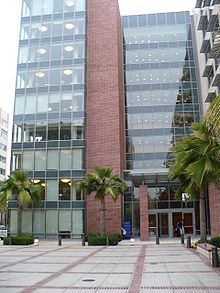
Rieber Terrace, a housing facility on campus
UCLA provides over 9,500 undergraduates with housing, in 14 complexes on the western side of campus, referred to by students as "The Hill." Students can live in halls, plazas, suites, or university apartments, which vary in pricing and privacy. Housing plans also offer students access to dining facilities, which have been ranked by the Princeton Review as some of the best in the nation. Dining halls are located in De Neve, Rieber, Covel, and Hedrick Halls. Residential cafes include Bruin Cafe, Rendezvous, and Cafe 1919. Cafe 1919's location formerly housed a cafe known as Puzzles. The university also provides housing to a limited number of graduate students. UCLA currently offers three years guaranteed housing to its incoming freshman, and one year to incoming transfer students. The Student Housing Master Plan, released October 2007, outlines goals to improve and expand student housing, including renovating older residential halls and allowing four years of guaranteed housing to all entering freshmen by 2010. According to the Daily Bruin, 1,525 beds, 10 faculty in-residence apartments and a 750-seat dining hall will be built on the Northwest Housing Infill Project on the Hill by 2013. The buildings are tentatively titled De Neve Gardenia Way, De Neve Holly Ridge, Sproul Cove, and Sproul Landing.
Hospitality
Hospitality constituents of the university include departments not directly related to student life or administration. The Hospitality department manages the UCLA Guest House, a full-service, on-campus hotel. The 61-room Guest House services those visiting the university for campus-related activities. The department also manages the UCLA Conference Center, a 40 acre (0.2 km²) convention center in the San Bernardino Mountains near Lake Arrowhead. Hospitality also operates UCLA Catering a Vending operation, and summer conference center located on the Westwood campus.
Other
The official UCLA site is ranked the sixteenth most accessed university site in the world by Alexa. Of universities in California, it is ranked third trailing only Stanford and UC Berkeley.
Faculty and alumni
See also: List of University of California, Los Angeles people
Six professors (two of whom are current faculty) and five alumni have been awarded the Nobel Prize for achievements in science, economics, and peace; notably Glenn T. Seaborg ('34) who was awarded the 1951 Nobel Prize in Chemistry, and Elinor Ostrom ('54), who was awarded the 2009 Nobel Memorial Prize in Economic Sciences. Fifty-two have been awarded Guggenheim Fellowships, and eleven are MacArthur Foundation Fellows. In 2006, 54 faculty members were listed as "Highly Cited" by the Institute for Scientific Information. Terence Tao, professor of Mathematics, was awarded the 2006 Fields Medal.
- 105 professors are members of the American Academy of Arts and Sciences
- 86 professors are members of the American Association for the Advancement of Science
- 16 professors are members of the American Philosophical Society
- 34 professors are members of the Institute of Medicine
- 20 professors are members of the National Academy of Engineering
- 40 professors are members of the National Academy of Sciences
- 6 professors are members of the National Academy of Education
Jared Diamond, a professor of Geography, won the 1998 Pulitzer Prize for his book Guns, Germs, and Steel. Two UCLA professors of history have each won 2008 Pulitzer Prizes for general nonfiction and history. Saul Friedländer, professor of history and noted scholar of the Nazi Holocaust, won the prize for general nonfiction for his 2006 book, The Years of Extermination: Nazi Germany and the Jews, 1939-1945, and Professor Emeritus Daniel Walker Howe won for his 2007 book, What Hath God Wrought: The Transformation of America, 1815-1848.
A number of UCLA alumni are notable politicians. In the U.S. House of Representatives, Henry Waxman ('61, '64) represents California's 30th congressional district and is Chairman of the House Energy and Commerce Committee. U.S. Representative Judy Chu ('74) represents California's 32nd congressional district and became the first Chinese American woman elected to the U.S. Congress in 2009. Kirsten Gillibrand ('91) is U.S. Senator from the State of New York and former U.S. Representative for New York's 20th congressional district. Antonio Villaraigosa ('77) is Mayor of Los Angeles, California and the third Mexican American ever to hold the office of mayor in the City of Los Angeles.
Computer scientist Vint Cerf ('70, '72) is Vice President and Chief Internet Evangelist at Google and the person most widely considered the "father of the Internet." Henry Samueli ('75) is co-founder of Broadcom Corporation and owner of the Anaheim Ducks.
UCLA alumni have also achieved prominence in the Arts and Entertainment. American composer John Williams is laureate conductor at the Boston Pops Orchestra and Academy Award winning composer of the Star Wars film score. Martin Sherwin (’71) was awarded the Pulitzer Prize for American Prometheus: The Triumph and Tragedy of J. Robert Oppenheimer. Actors Tim Robbins, James Franco, George Takei, and Milo Ventimiglia are also UCLA alumni. Popular music artists Sara Bareilles, The Doors, Linkin Park, and Maroon 5 all attended UCLA. Giada De Laurentiis is a program host at Food Network and former chef at Spago.
- 10 National Medal of Science winners (same as Harvard)
- 3 Presidential Medal of Freedom winners
- 11 Nobel laureates
- 3 Pulitzer Prize winners
- 1 Pritzker Prize in Architecture winner
- 1 Fields Medal in Mathematics winner
- 78 Guggenheim Fellows
- 11 MacArthur Fellows winners
- 11 Fulbright Scholars (since 2000)
- 5 California Scientist of the Year winners
更多
 |
Greater Los Angeles portal |
 |
University portal |
参考文献
- ^ UC Annual Endowment Report Office of the Treasurer of The Regents Retrieved March 31, 2010 (As of June 30, 2009. Of this amount, $982,212,000 is designated to the UC Regents for the benefit of the campus and $898,838,000 is held by the campus Foundation.)
- ^ UCLA (2007). "Gene D. Block". UCLA. http://www.ucla.edu/chancellor/. Retrieved 2007-05-16.
- ^ "UCLA Administration". Official site. Current. http://www.ucla.edu/administration.html. Retrieved 2007-05-20.
- ^ "UCLA Gateway". Official site. 2007. http://www.ucla.edu/about.html. Retrieved 2007-05-16.
- ^ "Campus Profile". Official site. Current. http://www.admissions.ucla.edu/campusprofile.htm. Retrieved 2007-05-20.
- ^ "Graphics Standards Manual" (PDF). University of California, Los Angeles. 2004-09-08. http://www.identity.ucla.edu/graphicstandards/UCLAStandardsManual0904.pdf. Retrieved 2008-03-16.
- ^ Ho, Melanie (2005). "Bruin Bear". UCLA English department. http://www.english.ucla.edu/ucla1960s/6263/bear.htm. Retrieved 2007-05-20.
- ^ "UCLA Campus Profile". UCLA. 2009. http://www.admissions.ucla.edu/campusprofile.htm. Retrieved 2009-11-07.
- ^ "UCLA Research Facts". Office of the Vice Chancellor for Research. 2006-2007. http://www.ovcr.ucla.edu/uploads/file/UCLA%20Research%20Fact%20Sheet%202009.pdf. Retrieved 2009-11-14.
- ^ DeCardenas, Diana (1999). "UCLA No. 1 in Applications". UCLA Today. http://www.today.ucla.edu/2000/000208ucla.html. Retrieved 2007-05-30.
- ^ "More Minorities in First Holistic Admission Class". UCLA Magazine. 2007-04-06. http://www.magazine.ucla.edu/exclusives/african-american-admissions-up/. Retrieved 2007-05-30.
- ^ Bartlett, Lauren (2007-01-24). "UCLA Remains the Country’s Most Popular University with More Than 50,000 High School Seniors Applying for Fall". UCLA News (UCLA). http://www.newsroom.ucla.edu/page.asp?RelNum=7664. Retrieved 2007-05-21.
- ^ http://www.universityofcalifornia.edu/admissions/undergrad_adm/selecting/camp_profiles/camp_profiles_ucla.html
- ^ "Profile of Admitted Freshmen Fall 2009". Official site. 2009-03-01. http://www.admissions.ucla.edu/prospect/adm_fr/Frosh_Prof09.htm. Retrieved 2009-05-06.
- ^ Enrollment data: Fall 2001–03 Fall 2002–04 Fall 2003–05. University of California System CSS Third Week Enrollment File (current). Retrieved May 30, 2007
- ^ http://colleges.usnews.rankingsandreviews.com/best-colleges/los-angeles-ca/ucla-1315
- ^ World's Best Universities: Top 400, US News and World Report, February 25, 2010
- ^ "Washington Monthly: 2009 National University Rankings". Washington Monthly. 2009. http://www.washingtonmonthly.com/college_guide/rankings/national_university_rank.php. Retrieved 2009-10-08.
- ^ "The Complete List: The Top 100 Global Universities". Newsweek. 2006. http://www.msnbc.msn.com/id/14321230/site/newsweek/. Retrieved 2007-05-20.
- ^ "ADRW 2007 Methodology". http://ed.sjtu.edu.cn/rank/2007/ARWU2007Methodology.htm. Retrieved 2008-11-24.
- ^ "Top American Research Universities". Center for Measuring University Performance. 2009. http://mup.asu.edu/research.html. Retrieved 2009-11-14.
- ^ Thomson Scientific (2002). "List of UCLA Highly Cited Researchers". ISI Highly Cited Researchers Version 1.1. http://hcr3.isiknowledge.com/browse_author.pl?link1=Browse&link2=Results&value=University+of+California,+Los+Angeles&submit=INSTITUTION&page=0. Retrieved 2006-12-02.
- ^ "1995 National Research Council Report on Quality in Ph.D. Education in the U.S." (PDF). National Research Council. 1995. http://www.grad.berkeley.edu/publications/pdf/nrc_rankings_1995.pdf. Retrieved 2006-07-06.
- ^ "NCAA". NCAA. http://web1.ncaa.org/web_files/stats/champs_records_book/summaries/combined.pdf. Retrieved 2009-11-14.
- ^ "UCLA Champions Made Here". UCLA Official Athletic Site. http://www.uclabruins.com/trads/no-1-combined-program.html. Retrieved 2009-11-14.
- ^ "UCLA Athletics Facts". UCLA Bruins. http://www.uclabruins.com/genrel/021204aaa.html. Retrieved 2009-11-14.
- ^ Hamilton, Andrew (2004-06-18). "(UC) Los Angeles: Historical Overview". University of California History, Digital Archives (from Berkeley). http://sunsite.berkeley.edu/UCHistory/general_history/campuses/ucla/overview.html. Retrieved 2006-06-20.
- ^ "UCLA University Archives". UCLA Library. 2007-01-20. http://www.library.ucla.edu/libraries/special/scweb/archives.htm. Retrieved 2006-06-20.
- ^ Garrigues, George (2001). "The Daily Bruin Is Born". Loud Bark and Curious Eyes, A History of the UCLA Daily Bruin, 1919–1955. http://www.ulwaf.com/Daily-Bruin-History/03_Birth.html. Retrieved 2006-07-03.
- ^ UCLA Alumni (2007). "Alumni & UCLA History". UCLA Alumni Association. http://www.uclalumni.net/AlumniStories/ImpactReport/History.cfm. Retrieved 2006-06-20.
- ^ Ko, Amy (1999). "Caught on Tape: Voices from UCLA's Past". UCLA Today. http://web.archive.org/web/20060901112349/http://www.today.ucla.edu/1999/991109caught.html. Retrieved 2008-01-25.
- ^ Kyle Swanson (2009). "In tough times, 'U' pushes forward with fundraising efforts". The Michigan Daily. http://www.michigandaily.com/content/2009-04-16/tough-times-u-pushes-forward-fundraising-efforts. Retrieved 2009-11-15.
- ^ Lindy Stevens (2009). "$3.2 billion Michigan Difference total announced". The Michigan Daily. http://www.michigandaily.com/content/na/32-billion-michigan-difference-total-announced. Retrieved 2009-11-15.
- ^ Hampton, Phil (2006). "UCLA Raises More Than $3 Billion ... Research Universities". UCLA News. http://www.newsroom.ucla.edu/page.asp?RelNum=6819. Retrieved 2007-05-18.
- ^ "Map of UNIVERSITY of California". Mapquest. Current. http://www.mapquest.com/maps/map.adp?latlongtype=internal&addtohistory=&latitude=%2fujp23Q4CoQyaX7fYDsWRA%3d%3d&longitude=8%2fGfpeQs3DIJqAXMypI90g%3d%3d&name=UNIVERSITY%20of%20California&country=US&address=405%20Hilgard%20Ave&city=Los%20Angeles&state=CA&zipcode=90095&phone=310%2d825%2d4321&spurl=0&&q=UCLA&qc=Colleges%20%26%20Universities. Retrieved 2007-05-29.
- ^ "Welton Becket and Associates". Emporis Buildings. 2007. http://www.emporis.com/en/cd/cm/?id=weltonbecketandassociates-losangeles-ca-usa. Retrieved 2007-05-29.
- ^ Lee, Cynthia (2004-10-12). "A 'sense of place' from the old and new". UCLA Today. http://www.today.ucla.edu/2004/041012closeup_senseofplace.html. Retrieved 2007-05-29.
- ^ Ong, Paul (2004). "The State of Southern California's Housing" (PDF). UCLA School of Public Affairs. http://lewis.sppsr.ucla.edu/research/publications/reports/SoCal_Housing.pdf. Retrieved 2007-05-02.
- ^ Dukakis, Michael and Shoup, Donald (2002). "Why BruinGO should stay". UCLA Today. http://www.today.ucla.edu/2002/020507bruingo.html. Retrieved 2007-05-22.
- ^ Morabito, Sam (2004-01-23). "UCLA Policy 863: Filming and Photography on Campus". UCLA Administrative Policies & Procedures Manual. http://www.adminvc.ucla.edu/appm/public/app_0863_0.html. Retrieved 2007-05-21.
- ^ "Jonathan Kuntz - Visiting Associate Professor". UCLA School of Theater, Film, and Television. 2007. http://www.tft.ucla.edu/faculty/facftv/index.cfm?action=showbio&alias=jkuntz&pagetype=blank. Retrieved 2007-05-21.
- ^ "About CNSI". California NanoSystems Institute. 2006. http://www.cnsi.ucla.edu/staticpages/about-us. Retrieved 2007-05-21.
- ^ "Best Hospitals 2006". U.S.News & World Report. 2007. http://www.usnews.com/usnews/health/best-hospitals/honorroll.htm. Retrieved 2006-12-02.
- ^ Shanghai Jiao Tong University (2009). "Academic Ranking of World Universities". Institute of Higher Education, Shanghai Jiao Tong University. http://www.arwu.org/ARWU2009.jsp. Retrieved 2009-12-23.
- ^ Shanghai Jiao Tong University (2009). "Ranking of North & Latin American Universities". Institute of Higher Education, Shanghai Jiao Tong University. http://www.arwu.org/Americas2009.jsp. Retrieved 2009-12-23.
- ^ The Times (2009). "World University Rankings". The Times Higher Educational Supplement. http://www.topuniversities.com/university-rankings/world-university-rankings/2009/results. Retrieved 2010-02-09.
- ^ "National Universities Rankings". America's Best Colleges 2009. U.S. News & World Report. 2009. http://colleges.usnews.rankingsandreviews.com/college/national-search. Retrieved 2009-05-18.
- ^ "The Washington Monthly National University Rankings" (PDF). The Washington Monthly. 2009. http://www.washingtonmonthly.com/college_guide/rankings/national_university_rank.php. Retrieved 2009-12-23.
- ^ "Times Higher Education - QS World University Rankings 2008 - Top 400 Universities". The Times Higher Education Supplement. 2008. http://www.topuniversities.com/worlduniversityrankings/results/2007/overall_rankings/top_400_universities/. Retrieved 2008-08-15.
- ^ U.S. News & World Report, 2009 Public University Rankings Retrieved July 15, 2009.
- ^ Kantrowitz, Barbara and Springen, Karen (2006). "25 New Ivies". Newsweek. http://www.newsweek.com/id/46417/page/12. Retrieved 2006-08-18.
- ^ "National Universities". The Washington Monthly. August 2009. http://www.washingtonmonthly.com/college_guide/rankings/national_university_rank.php. Retrieved 2009-10-08.
- ^ Winter, Sarah (2006-05-10). "Research dollars recognized". The Daily Bruin. http://www.dailybruin.ucla.edu/news/2006/may/10/research-dollars-recognized/. Retrieved 2006-07-06.
- ^ "America's Best Graduate Schools 2008". US News. 2007. http://www.usnews.com/usnews/edu/grad/rankings/rankindex_brief.php. Retrieved 2007-07-07.
- ^ "The Nation's Largest Libraries". American Library Association. 2007. http://www.ala.org/ala/alalibrary/libraryfactsheet/alalibraryfactsheet22.cfm. Retrieved 2006-12-12.
- ^ "A Tribute to Lawrence Clark Powell". UCLA Library. 2006. http://www.library.ucla.edu/special/scweb/lcpintro.htm. Retrieved 2006-12-13.
- ^ Setzer, Dawn (2006-03-09). "Obituary: Page Ackerman, Former UCLA University Librarian". UCLA News. http://newsroom.ucla.edu/page.asp?RelNum=6884. Retrieved 2006-12-13.
- ^ "University Librarian Gary E. Strong". UCLA Library. 2007-05-11. http://www2.library.ucla.edu/about/ul.cfm. Retrieved 2007-05-21.
- ^ "UCLA admissions data show high academic quality for 2008 freshmen". 2008-04-14. http://newsroom.ucla.edu/portal/ucla/ucla-admissions-data-show-high-48543.aspx. Retrieved 2008-05-11.
- ^ "UCLA at Princeton Review". Princeton Review. http://princetonreview.com/college/research/profiles/generalinfomore.asp?listing=1023373<id=1. Retrieved 2007-05-30.
- ^ "Enrollment Summary, Fall 2007" (PDF). UCLA Office of Analysis and Information Management. http://www.aim.ucla.edu/Statistics/enrollment/SummaryFall2007.pdf. Retrieved 2008-04-01.
- ^ Leonhardt, David (2007-09-30). "The New Affirmative Action". The New York Times Magazine. http://www.nytimes.com/2007/09/30/magazine/30affirmative-t.html?pagewanted=1&_r=1&ref=magazine. Retrieved 2007-09-28.
- ^ Smallwood, Scott (2006-09-29). "UCLA Adopts 'Holistic' Model in Admissions to Stem Decline in Minority Enrollment". The Chronicle of Higher Education. http://chronicle.com/news/article/1061/ucla-adopts-holistic-model-in-admissions-to-stem-decline-in-minority-enrollment. Retrieved 2007-05-21.
- ^ "Economic Diversity Among All National Universities", US News and World Report, http://colleges.usnews.rankingsandreviews.com/usnews/edu/college/rankings/brief/natudoc_ecodiv_brief.php, retrieved 2007-08-10
- ^ "America's Best Colleges". U.S.News & World Report. 2007. http://www.usnews.com/usnews/edu/college/directory/brief/drglance_1315_brief.php. Retrieved 2006-06-25.
- ^ Largest Employers in Los Angeles County. Compiled by the LA Almanac, Source: California Employment Development Department, The Los Angeles Business Journal, and Almanac research
- ^ UCLA — A Smart Investment for the Greater Los Angeles Region ... and Beyond
- ^ (Chinese) "UCLA Store List". UCLAstore.com.cn. http://www.uclastore.com.cn/StoreList.asp. Retrieved 2006-12-26.
- ^ Fernando, Menaka (2005-04-05). "UCLA name, L.A. lifestyle marketable overseas". The Daily Bruin (UCLA). http://www.dailybruin.ucla.edu/news/2005/apr/05/ucla-name-la-lifestyle-marketa/. Retrieved 2005-05-13.
- ^ "Bruins lead the nation with 105 NCAA team championships and 124 total national championships". UCLA Bruins. 2008. http://uclabruins.cstv.com/genrel/ucla-100-champs.html. Retrieved 2008-05-31.
- ^ "National Championships". UCLA Bruins. 2007. http://uclabruins.cstv.com/genrel/ucla-100-champs.html. Retrieved 2007-05-22.
- ^ http://grfx.cstv.com/photos/schools/ucla/sports/m-volley/auto_pdf/2010-mg-section2.pdf
- ^ http://grfx.cstv.com/photos/schools/ucla/sports/w-volley/auto_pdf/2007-mg-section-04.pdf p.51
- ^ http://grfx.cstv.com/photos/schools/ucla/sports/m-soccer/auto_pdf/09-msoccer-mg-opponents.pdf p. 42
- ^ "Lexus Gauntlet". CollegeSports. http://lexusgauntlet.collegesports.com/index-south.html. Retrieved 2007-04-13.
- ^ "UCLA's Olympic Medal Winners". UCLA Bruins. 2004. http://uclabruins.cstv.com/ot/olympic-medalists.html. Retrieved 2007-05-22.
- ^ "USC OLYMPIANS: 1904–2004" (PDF). Fans Only (CSTV). 2004. http://graphics.fansonly.com/photos/schools/usc/genrel/auto_pdf/uscolympians.pdf. Retrieved 2007-05-22.
- ^ UCLA Women's Tennis Claims First-Ever NCAA Championship - Zalameda named tournament's most outstanding player in 4-0 win over No. 8 Cal
- ^ http://www.cnn.com/2009/CRIME/10/10/ucla.stabbing/index.html
- ^ http://www.msnbc.msn.com/id/33236949/ns/us_news-crime_and_courts/
- ^ UCLA UniCamp www.unicamp.org
- ^ "What's DM?". Bruin Dance Marathon. 2007. http://bruindancemarathon.org/about-newsite.html. Retrieved 2007-05-21.
- ^ Staines, Xandi (2005-06-13). "Undie Run tradition faces growing pains". The Daily Bruin. http://www.dailybruin.ucla.edu/archives/id/33295. Retrieved 2007-06-13.
- ^ Rushovich, Colin (2005-12-12). "Undie Run safety at issue". The Daily Bruin. http://www.dailybruin.ucla.edu/news/2005/dec/12/undie-run-safety-at-issue/. Retrieved 2007-05-21.
- ^ http://newsroom.ucla.edu/portal/ucla/ucla-ends-student-undie-run-due-97231.aspx
- ^ "Gershwin Award Winners". Alumni Association. 2007. http://www.uclalumni.net/CalendarEvents/springsing/Gershwin/winners.cfm. Retrieved 2007-05-21.
- ^ Lional Richie accepts the Gershwin Award
- ^ Valentine, Jane (2004-01-21). "Dinner with 12 strangers is a feast for friends". UCLA Today. http://www.today.ucla.edu/2004/040121voices_mind.html. Retrieved 2007-05-21.
- ^ http://www2.guidestar.org/ReportNonProfit.aspx?ein=95-1777979&name=associated-students-ucla#
- ^ http://gsa.asucla.ucla.edu/
- ^ UCLA Undergraduate Students Association
- ^ http://www.studentmedia.ucla.edu/mediacenter/section.asp
- ^ "2006 Mark of Excellence - National Winners/Finalists". Society of Professional Journalists. 2006. http://www.spj.org/moe06.asp. Retrieved 2007-05-26.
- ^ "The Best 371 Colleges: Quality of Life - Campus Food". http://www.princetonreview.com/schoollist.aspx?type=r&id=683&RDN=1. Retrieved 2010-04-20.
- ^ UCLA (October 2007). "UCLA Student Housing Master Plan 2007-2017" (PDF). UCLA official site. http://www.housing.ucla.edu/SHMP/SHMP-2017-3.pdf. Retrieved 2008-01-25.
- ^ Noble, Brett (2008-06-04). "Project to increase housing options". Daily Bruin. http://www.dailybruin.com/news/2008/jun/04/project-increase-housing-options/. Retrieved 2008-06-09.
- ^ "Guest House Hotel". Official site. 2007. http://map.ais.ucla.edu/portal/site/UCLA/menuitem.3f8e7342ad4ca217b66d4ab4f848344a/?vgnextoid=fd5af9f9bd19ff00VgnVCM1000008f8443a4RCRD. Retrieved 2007-05-21.
- ^ "Conference Center at Lake Arrowhead". Official site. 2007. http://map.ais.ucla.edu/portal/site/UCLA/menuitem.3f8e7342ad4ca217b66d4ab4f848344a/?vgnextoid=ec175645ff212010VgnVCM1000008f8443a4RCRD. Retrieved 2007-05-21.
- ^ "UCLA Catering". official cite. 2009. http://map.ais.ucla.edu/go/campus-services/hospitality/catering.
- ^ "Conference Services". Official site. 2007. http://map.ais.ucla.edu/portal/site/UCLA/menuitem.3f8e7342ad4ca217b66d4ab4f848344a/?vgnextoid=143d396579b8ff00VgnVCM1000008f8443a4RCRD. Retrieved 2007-05-21.
- ^ UCLA.edu
- ^ Alexa (UCLA.edu) (Retrieved March 1, 2010.)
- ^ Alexa Rankings (Retrieved March 1, 2010.)
- ^ "The Nobel Prize in Chemistry 1951". Nobel Foundation. 2007. http://nobelprize.org/nobel_prizes/chemistry/laureates/1951/index.html. Retrieved 2007-05-21.
- ^ UCLA (2009). "UCLA Alumna Elinor Ostrom Wins 2009 Nobel Prize in Economics". Official site. http://newsroom.ucla.edu/portal/ucla/ucla-alumna-elinor-ostrom-wins-111209.aspx. Retrieved 2009-10-12.
- ^ "The Pulitzer Prize Winners in 1998". Pulitzer Board. 2007. http://www.pulitzer.org/year/1998/general-non-fiction/. Retrieved 2007-05-21.
- ^ "Democrats Oust Longtime Leader of House Panel". New York Times. 2008. http://www.nytimes.com/2008/11/21/us/politics/21dingell.html. Retrieved 2008-11-20.
- ^ "Judy Chu becomes first Chinese American woman elected to Congress". Los Angeles Times. 2009. http://articles.latimes.com/2009/jul/16/local/me-judy-chu16. Retrieved 2009-07-16.
- ^ "Gillibrand appointed to Senate seat". New York Times. 2005. http://www.boston.com/news/nation/articles/2009/01/24/gillibrand_appointed_to_senate_seat. Retrieved 2005-05-18.
- ^ "L.A. Elects Hispanic Mayor for First Time in Over 100 Years". Boston Globe. 2009. http://www.nytimes.com/2005/05/18/national/18cnd-angeles.html?hp. Retrieved 2008-01-24.
- ^ "Cerf urges standards for cloud computing". InfoWorld. 2010. http://www.infoworld.com/d/cloud-computing/cerf-urges-standards-cloud-computing-817. Retrieved 2010-01-08.
- ^ http://www.aim.ucla.edu/profile/main.asp
External links
 |
Wikimedia Commons has media related to: UCLA |
- Official site
- Official Daily Bruin 网址
- UCLA MAC
- UCLA's Weyburn Hall dormitory 1967-1971, Westwood, CA
- UCLA's 2006 Men's Volleyball National Championship



